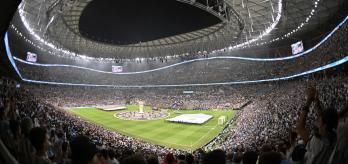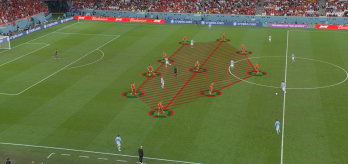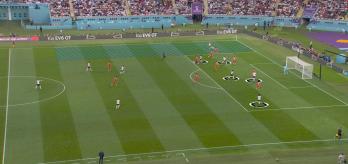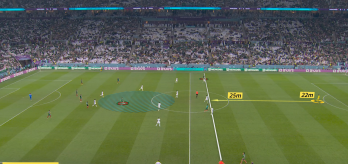All four semi-finalists won their quarter-final matches with less than, or equal to, the possession of their defeated opponents.
Interestingly in the semi-finals, the teams with significantly less possession – France and Argentina – progressed to the final. Morocco's 56% possession in their semi-final defeat to France was the first time they had more possession than their opponent in the tournament and the first time they conceded more than one goal.
When this was investigated further, it was discovered that teams which had 33% or less ball possession totalled just five losses versus 14 wins or draws. In contrast, teams with 57% or more possession had seven wins versus seven losses or draws.
According to Arsène Wenger, FIFA's Chief of Global Football Development, these numbers demonstrate a clear issue with some teams' ability to score goals against organised opponents.
"The target is always to be good in all areas when you have possession of the ball. Teams that dominate possession but do not win games, demonstrate a deficit in efficiency in some positions in their team.
"It is easier to be more efficient on the counter-attack. If the team that does not have the ball can be disciplined, and if the team that has the ball doesn't score, slowly, the team with the ball will take more risks, so it is possible to get better quality chances on transition to attack," he explained.
To win the World Cup, a team must be excellent when they are dominating possession and have the capacity to break down organised defences to score goals. But they also must be able to control the game when they do not have possession of the ball, to stop their opponents from scoring.
To understand how the best teams at FIFA World Cup Qatar 2022™ behaved when they did not have the ball, the above observations prompted us to ask the following questions:
- When teams did not have the ball, what was their preferred out-of-possession game phase?
- What were the key components in the application of this game phase?
Defining a mid-block
There are nine out-of-possession game phases defined in the FIFA Football Language and data collection metrics: High Press, Mid Press, Low Press, High-Block, Mid-Block, Low-Block, Recovery, Defensive Transition and Counter Press.
Our analysis gave an interesting insight into the use of the mid-block and the compactness of this block during FIFA World Cup 2022.
A mid-block occurs when a team that does not have the ball connects the defensive lines of their team shape and holds a collective position in the middle (or middle and defensive) third of the pitch. The focus of a mid-block is to be compact and narrow collectively, denying the opposition space to play through the central channels of the pitch. The intention is often to force the opposition wide or backwards and to use their attempts to play centrally as opportunities to win the ball back.
The following three key metrics are used to define mid-blocks for data collection purposes:
"Stationary" means that a player is not moving forward or backward at more than 10 km/h. In other words, they are staying in one place or moving very slowly (as opposed to pressing, when players are making fast, deliberate movement towards the opposition player in possession).
"Organised" means that a team is positioned in a certain way on the field. Specifically, the players (except for the highest positioned player) form horizontal lines and the team has been stationary for at least 1.6 seconds during the previous 2.0 seconds. Additionally, there must be at least four defending players organised behind the ball and not meeting the criteria of a "Low-Block".
A mid-block is when there are at least eight outfield defending players in the middle third of the pitch, or the middle and defensive third of the pitch (a low-block occurs when eight out-field players are in the defensive third only).
The mid-block phase ends when one of the following happens:
- The block criteria is not fulfilled for 0.4 seconds within 2.0 seconds
- Possession changes
- The ball goes out of play
Time spent in a mid-block
Of the 32 teams participating at the FIFA World Cup 2022, Morocco spent the greatest proportion of out-of-possession time, in a mid block. The Atlas Lions spent 38% of their time without the ball operating in this type of phase (Figure 4).
Fellow semi-finalists and tournament runners-up France were second with 37%. Winners Argentina ranked fourth overall with 32%.
While Croatia's 25% ranks lower, the mid-block was their dominant out-of-possession phase in all but three games. In these three matches the low-block was their predominant phase with the mid-block ranking second.
At 9%, Spain were the lowest ranked team for time spent out of possession in a mid-block. Of the ten lowest ranked teams, only Spain and Portugal progressed to the knockout stages, with Portugal being the only team to reach the quarter-finals.
Compactness
"Compactness" is a significant factor when a team is organised in a block. The compactness of a team is determined by measuring their width and length when in a block phase. The more compact and narrow a team is, the less space available for their opponents to play between their lines. However, being compact also means more space is conceded in other parts of the pitch; finding the balance in compactness is extremely important.
At the 2022 World Cup, our analysis found that bronze medallists Croatia were most consistently aligned with the tournament average (27.2m v 40.1m) for compactness when in a mid-block, with an average team length of just over 27.3m and an average width of 40.1m.
Tournament winners Argentina were above average for both width (40.5m) and length (29.1m) when in a mid-block, utilising both a back four and a back five throughout the competition.
Runners-up France assumed a narrow shape (38.4m) but were slightly above average in team length (27.3m) when in a mid-block.
Of the 16 teams that progressed to the knockout stages, seven (USA, Poland, Korea Republic, Spain, Australia, Morocco and Japan) were among the most compact in the tournament. However, of those seven teams only Morocco (40.75m wide x 23.5m long) advanced to the quarter-finals.
The use of the compact mid-block was a key success factor in Morocco's 2022 World Cup journey, which saw them become the first ever CAF nation to reach the semi-final stage.
Interestingly, Saudi Arabia were the most compact of all teams in the tournament (39.6m wide x 22.5m long) and their dominant out-of-possession phase in their 2-1 group-stage victory over Argentina was their compact mid-block. The Green Falcons' commitment to remaining tightly connected, relentless communication and pushing on with players who were making movements to receive, made it extremely difficult for Argentina to break their lines or play through them (see Clip 3).
Korea Republic, Poland and USA proved to be most narrow in their blocks while Saudi Arabia, Morocco and Japan had the tightest team lengths.
Serbia, Canada, the Netherlands, Mexico, Wales and tournament winners Argentina were the least compact of the 32 teams when the averages are compared. The clips below show the different approaches used by Serbia (Clip 4) and the Netherlands (Clip 5) when adopting a mid-block with a back five.
The data also established that teams utilising a back four tended to be more compact than those operating in a back five.
Furthermore, the longer teams spent in a mid-block the more compact they became, and teams also demonstrated a greater willingness to employ compact mid-blocks when winning or drawing. When losing, teams spent less time in mid-blocks and the overall area occupied by the team structure was larger.
Why and how did teams use mid-blocks?
There are several reasons why teams use mid-blocks. According to Wenger the mid-block can be a preferred defensive phase for the following reasons:
"The mid-block is possibly the best out-of-possession phase for coaches who favour alternating between pressing and positional play. Collectively, the team operating in a mid-block can choose the right moment to initiate a press or can wait until an error is forced and the opposition loses the ball."
1. To stop opposition teams from progressing the ball and force errors
Once a team has commenced a mid-block phase, the intention is to protect the central channel of the pitch and deny the opposition from playing through the lines of their defence or from receiving the ball inside their team shape. Passes by their opponent that attempt to breach these areas will often result in pressing actions to force the ball backwards or an error that results in a turnover in possession.
In their quarter-final match against the Netherlands, Argentina demonstrated a disciplined willingness to consistently shift as a team: players communicated when they had to push on as a result of attempts by the Netherlands to play through or inside their team shape, and the units of the team moved collectively to maintain the distances between the lines and deny space inside their team shape.
A similar patient approach is adopted by the Netherlands in their group-stage match against Ecuador. The units of the team move together in a synchronised and disciplined way, eventually forcing Ecuador to play a long ball and lose possession.
2. To initiate a clear pressing strategy
Because mid-blocks take place in the central third of the pitch, they allow the opposition team to commence their build-up phase in their own half unopposed.
Teams in a mid-block can then use the expectations and predictability of their opponent's in-possession patterns to establish pressing triggers and assign pressing actions to their players. As a result, whenever a certain pass is made or attempted by the opponent, a predefined press can be engaged whereby each player in the mid-block knows their own responsibilities and those of their team-mates.
When teams in a mid-block win the ball back, the distance to the opposition goal is shorter than that in a transition to attack from a low-block. If a team is opting for a high-block, then they must employ a high defensive line which can leave them vulnerable in behind – particularly against a team with pacy forwards.
Morocco spent the most out-of-possession time in a mid-block of all teams and one of their key success factors was the compactness of their shape. As we can see in the examples below, players also had clear roles in terms of how and when to protect the space they occupied, with pre-identified triggers based on attempts by their opponents to breach their team shape.
3. To counter-attack explosively on transition to attack
An important consequence of a possession regain when in a mid-block phase is the opportunity to initiate a counter-attack. As teams in possession gradually take more risks to break down a mid-block, their rest defence structures become more open, leaving the team more vulnerable to counter-attacks should they lose possession.
To take advantage of this vulnerability, the first two passes or actions after the ball is won are crucial for enabling an efficient counter-attack. Securing possession and progressing the ball forward through direct dribbling or quick vertical passes, accompanied by forward runs from other players, can expose space left unprotected.
As demonstrated by Ecuador and France in the clips below, the successful employment of a mid-block can result in a counter-attacking opportunity if the ball is secured and progressed positively following a possession regain.
Summary
- The best teams at FIFA World Cup Qatar 2022 had the ability to score goals against organised defences when they were dominating the ball, but also demonstrated an ability to control the game when they did not have possession.
- Defending in a mid-block proved to be a popular out-of-possession strategy for teams that made it through to the latter rounds of the competition, with all four semi-finalists preferring the mid-block as their dominant phase when without the ball.
- Champions Argentina demonstrated flexibility and a willingness to adapt their team shape throughout the competition, utilising both a back four and a back five. Interestingly, teams operating with a back four were found to be more compact than those operating with a back five.
- Croatia's average team length of just over 27m and an average team width of 40.1m was the most consistent with the overall tournament average for mid-block compactness.
- Morocco were more consistent in their approach and spent most time in a mid-block of all teams at the tournament but became less compact when they needed to score.
- When teams employed a mid-block, being disciplined with strong communication and the ability to respond to triggers when opponents attempt to play through or break lines proved crucial, especially when attempting to maintain compactness.
- Playing through an effective, compact mid-block is difficult and can force attacking teams to focus on exploiting the wider areas of the pitch or space in behind the defensive line in order to progress the ball.






.variant64x64.png)





.variant348x164.png)
